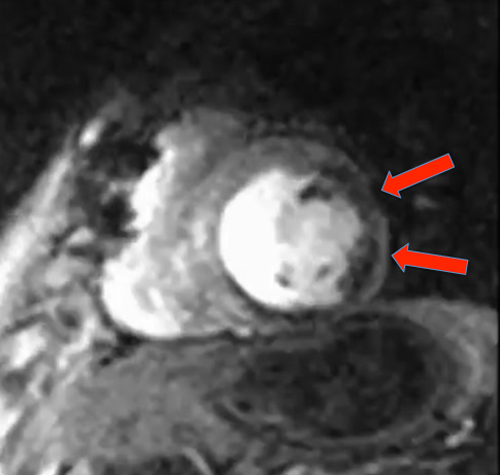The purpose of this website is to explain the physical principles underlying MR imaging, not to delve into the details of clinical interpretation. Nevertheless, a brief summary of cardiac MR imaging findings in the setting of coronary insufficiency and myocardial infarction may be helpful in allowing readers to better appreciate what cardiologists and radiologists are looking for when they view these studies. What follows are very general statements only that do not reflect many subtleties and nuances of image interpretation that take years of training and experience to acquire.
The four sets of imaging data (wall motion, stress perfusion, rest perfusion, and delayed contrast enhancement) must be carefully evaluated side-by-side and correlated with clinical findings to arrive at a complete diagnosis.
Perfusion defects representing hemodynamically significant stenoses are typically visible only on stress imaging (or at least they are much more pronounced than those seen at rest). In the setting of recent myocardial infarction, prominent perfusion defects at both stress and rest occur when the relevant coronary artery is occluded or demonstrates a "no-reflow" phenomenon (microvascular obstruction).
The size of the defect on first-pass perfusion images usually matches well with the area of late enhancement. A perfusion defect that is substantially larger than the area of late gadolinium enhancement may reflect a penumbra or area at risk = treatable coronary artery stenosis.
Advanced Discussion (show/hide)»
No supplementary material yet. Check back soon!
References
Coelho-Filho OR, Rickers C, Kwong RY, Jerosch-Herold M. MR myocardial perfusion imaging. Radiology 2013; 266:701-725.
Wu KC, Zerhouni EA, Judd RM, et al. Prognostic significance of microvascular obstruction by magnetic resonance imaging in patients with acute myocardial infarction. Circulation 1998; 97:765-772.
Coelho-Filho OR, Rickers C, Kwong RY, Jerosch-Herold M. MR myocardial perfusion imaging. Radiology 2013; 266:701-725.
Wu KC, Zerhouni EA, Judd RM, et al. Prognostic significance of microvascular obstruction by magnetic resonance imaging in patients with acute myocardial infarction. Circulation 1998; 97:765-772.
Related Questions
Can myocardial perfusion be quantified?
Can myocardial perfusion be quantified?

